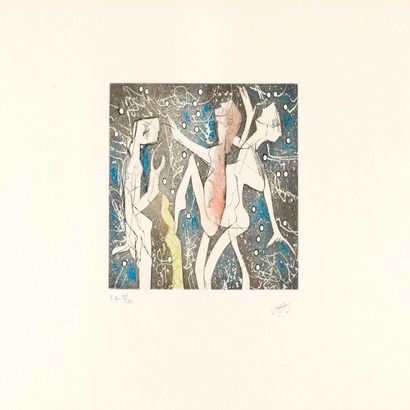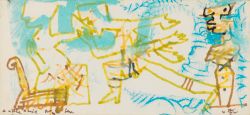Roberto Matta, an artist recherché
In the surrealist magazine Minotaure, Matta wrote texts on architecture that opposed the rationalism of Corbusier. An important stage for Matta intervenes however during the summer 1939 when, accompanied by Esteban Francès and Gordon Onslow-Ford, he stays at the castle of Chemillieu. They were joined by André Breton and his family, Yves Tanguy and Kay Sage. It seems that the presence of Yves Tanguy was particularly important in Matta's training at this time. At the same time, he painted a series of paintings for which he experimented with a new technique: with a cloth, he spread the color on the canvas, which, thus spread, decides the subsequent line of the brush. It is similar to the process of automatic writing. He calls this series "Psychological Morphologies".
Roberto Matta, There Figures, 1958c, M.T. Center. Abraham Center.
He left for New York at the request of Marcel Duchamp to escape the war. Six months after his arrival, he exhibited for the first time in the United States at the Julien Levy Gallery, which specialized in surrealism. Matta began working with phosphorescent pigments to give his canvases the ability to produce images that would vary according to the wavelength of the light. He was inspired by the scientific press5 and was fascinated by relativistic physics and theories related to the fourth dimension. He also illustrates with a lamprey's mouth the cover of the 4th issue of the surrealist magazine VVV in February 1944. He gave lectures at the New School of Social Research and received many young Americans in his studio, including Jackson Pollock.
He illustrated Denis de Rougemont's Letters on the Atomic Bomb, which was published in New York by Brentano in 1946.
In September 1947, his first monographic exhibition in Paris was organized. The exhibition catalog includes a text by Breton written in 1944: "The pearl is spoiled in my eyes ... ".
Roberto Matta founded with Patricia Kane Matta (1923-1972) (who would become the wife of Pierre Matisse) the magazine Instead which includes seven issues including a double (No. 5-6) and consists of a sheet of 56 × 71 cm, folded into three and printed on both sides. Instead appeared from January to November 1948 with a contribution by Stephane Hessel.
n
In October 1948, he was excluded from the Surrealist group. Breton suspected him of an affair with the wife of the painter Arshile Gorky, the cause of his suicide. Matta then returned to Chile. He published a text insisting on the "role of the revolutionary artist, who must rediscover new emotional relationships between men. He then returned to Europe and settled in Italy, first in Ischia (where he befriended Leonardo Cremonini) and then in Panarea (where Leonardo Cremonini's wife, Giovanna Madonia, had Malitte Matta buy a house), his complicity with Leonardo Cremonini lasted until his death.
In 1952, the trial of Julius and Ethel Rosenberg inspired him to create The Rosenbelles.
In 1958, after reading Henri Alleg's book The Question, recounting the torture suffered during the Algerian War, he painted The Question, Djamila.
In 1964, to pay tribute to the communist leader Julian Grimau, executed in Spain the previous year, he painted The Powers of Disorder, a composition 9 meters long.
Burn, baby burn (1965-1967) is a stigmatization of the Vietnam War.
Matta is very comfortable in very large formats; his paintings are often several meters long, even 10 meters and sometimes more. In 1968, he created environments by covering the walls and ceilings of the Museum of Modern Art of the City of Paris with his paintings.
That same year, in January, Matta participated in the first cultural congress in Havana, Cuba. In France, he took an active part in the events of May.
After the coup d'état of General Pinochet in Chile on September 11, 1973, he cut all ties with his native country:
"It is this exile that has determined my whole life, between two cultures. My work is a work of separation. [...] From exile, I passed to the "Ex-il", somewhere between the known and the unknown, between reality and the imaginary. Where poetry begins."
In 1985, he received the Gold Medal of Merit of Fine Arts by the Ministry of Education, Culture and Sports.
Descendants
Matta is the father of twins Gordon Matta-Clark and John Sebastian Matta, born in 1943 and died, the first in 1978 and Sebastian, known as Batan, in 1976; Pablo Echaurren born in 1951, Federica Matta, born in 1956, Ramuntcho Matta, born in 1960 and Alisée Matta, born in 1969.
What is the value of Matta's paintings in the art market?
The results obtained in public auctions are quite variable, ranging from 26,000 euros to 80,000 euros for similar formats.
|



